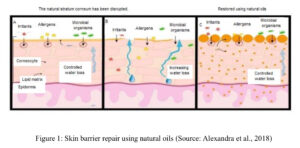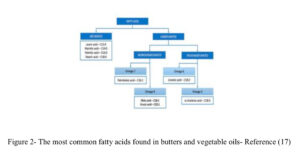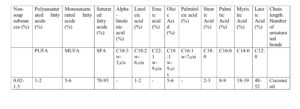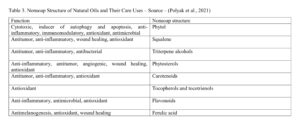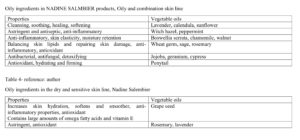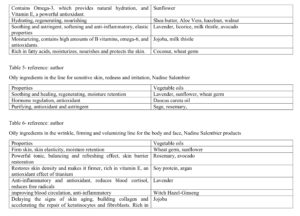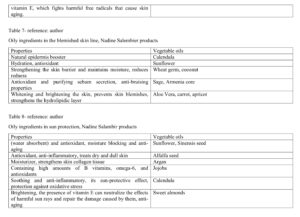Author: Fatemeh Yazdani
FARANAKYAZDANY1365@YAHOO.COM
Abstract
Natural butters and oils have been used for centuries for their favorable therapeutic and cosmetic benefits on skin health and are still extensively utilized today in the pharmaceutical, health and cosmetic sectors. For instance, they serve as key components in extraction solvents and excipients. Fixed (non-volatile) oils derived from plants or animals are referred to as natural oils. Unlike essential (volatile) oils, these oils are produced by steam distilling plant materials. They are typically extracted by solvent extraction or mechanical pressing from plant seeds and kernels. Many natural oils are appealing substitutes and supplemental therapies for dry and inflammatory
dermatoses linked to skin barrier abnormalities because they contain particular chemicals with antibacterial, antioxidant, anti-inflammatory, and antipruritic qualities. When evaluating various oils for topical skin care, it’s important to take into account their distinct qualities. This review article aims to determine the advantages and disadvantages of each oil by thoroughly analyzing the experimental and practical data supporting the use of vegetable oils, (natural) oils, and essential oils in a range of skin care and cosmetic products. We will also go over the advantages and disadvantages of utilizing natural oils in skin-softening products, as well as how they may be used to treat skin conditions and heal wounds. Nonetheless, new studies on vegetable oils and the finest oils for face skin have given us intriguing details about their components and mechanisms of action. The study’s findings have shown how these oils improve skin appearance, cure skin conditions, and explain their efficacy.
Keywords
Skin care, Moisturizing herbal skin medicines, Natural oils, Vegetable oils and essential oils, Nadine Salmiber.
1- Introduction
The skin, as part of the body’s protection system, plays several important tasks in the body. It consists of many layers, each of which performs a vital function in safeguarding the body. The outermost layer is known as the Stratum Carneum, or brick wall. This protective wall is composed of resistant cells known as corneocytes, as well as keratin and natural moisturizers bound together by lipids. Lipids
are the skin’s natural leather and are divided into three groups: cholesterol, free fatty acids, and ceramides. The skin’s lipid layer’s primary role is to keep water from leaving from the underlying layers of the skin and external elements from entering. Sunburn, irritation, itching,peeling, or skin redness are all signs of damage to this protective barrier. The skin barrier has several roles, many of which are connected to health. Researchers generally agree that the skin serves three important functions: shielding the body from external stresses such as
pollution and UV radiation, storing water to keep the body and skin moisturized, and carrying key nutrients to the skin. Overall, these variables work together to maintain the body’s many systems balanced. The skin’s barrier is also a significant factor in skin health and evenness. When lipids, the natural fats that help maintain skin health, degrade, the skin’s barrier is compromised, resulting in small, microscopic fractures on the skin, and moisture evaporates through these crevices, leaving the skin feeling dry and strained. It also loses brilliance and clarity, making it seem dull and drab. There are several reasons why this occurs. First, there are uncontrolled elements
such as genetics, age, and environmental contaminants. Damaged skin, a frequent dermatological topic, permits irritants, allergens, and microorganisms to enter, resulting in inflammation due to an excessive immune response. AD is a primary inflammatory skin disease with reduced barrier function, marked by increased TEWL, decreased SC hydration, elevated pH, and decreased sebum levels. Psoriasis, ichthyosis, atopic eczema, and contact dermatitis are some of the chronic inflammatory skin disorders linked to skin barrier failure. Furthermore, barrier function declines with age, resulting in a decrease of water retention in the skin, which eventually leads to hydration
loss. Aged skin has less SC lipids and less water. Exogenous and endogenous irritants and allergens may harm and aggravate skin barrier failure by destroying structural proteins, depleting MMF, and modifying critical lipid-based structures. Exaggerating the immunological response to the irritation Environmental influences, as well as genetic abnormalities in barrier repair genes, may affect the SC’s structure and function. Dysfunction of the skin SC also alters the skin microbiota, enabling pathogenic organisms to grow and dominate,
exacerbating skin barrier breakdown and inflammation. A weakened skin barrier is related with elevated PHSE, which promotes barrier breakdown and inflammation. [29] Skin care specialists and patients are always searching for the best moisturizer for skin restoration. Patient preferences often influence the acceptability and efficacy of a moisturizer. Moisturizers heal the SC via two major mechanisms:
(a) delivering hydration through hydrophilic chemicals like glycerol and (b) preventing TEWL by blocking the skin barrier with hydrophobic components like petroleum jelly. There is also evidence that hydrophobic components like petroleum jelly may permeate into the intercellular space in the SC, improving the barrier’s structural integrity. Topical repair products also include CERS,, hyaluronic acid, Butyrospermum parkii (shea butter), and natural oils such Simmondsia chinensis, jojoba oil, and Helianthus annus (sunflower oil). The moisturizing components work together to increase the SC’s water content and corneal adherence, allowing the SC to remain smooth and flexible. The SC works as a permeability barrier, restricting the intake of possible irritants from
the outside environment and keeping water from leaving the body. In turn, essential SC components such as NMFS, keratin, and FLG contribute to the formation, degradation, and rebuilding of the permeability barrier, ensuring enough water for optimal skin barrier function. [1] Oils and oil-based moisturizers increase SC hydration by occluding the skin and reducing water outflow, resulting in more water retained inside the SC. According to Van Lagsten et al., topical oil application not only enhances hydration via occlusion, but also produces a depth-dependent increase in hydration throughout the SC, with the upper middle layer receiving the most hydration. This is congruent with the results of Choe et al., who discovered that lateral lipid packing and intercellular lipid composition are maximum at 20-40% of the SC depth and correlate with the best skin barrier function [2].
A key component of atopic dermatitis treatment is repairing the skin barrier’s ability to retain moisture, which keeps allergens and microorganisms from entering and regulates itching. Because the components are private, customers and providers may be ignorant of allergic and irritating substances, such as preservatives and scents. Barrier-repairing emollients, on the other hand, are costly and hence inaccessible to many patients, leading patients and caregivers to seek alternate treatment choices (Loden et al. 2013). Natural, preservative-free solutions are an appealing choice for barrier restoration. Natural plant oils have been utilized for hundreds of years by civilizations all over the globe to preserve vitality and health in a number of ways, including skin health and attractiveness. [4] There are several varieties of natural oils with varying lipids.
2- Structure of natural oils
In the present day, natural products have emerged as a favored alternative in the realm of health care and treatment. Natural plant oils are frequently employed as topical treatments worldwide. They are typically readily accessible and relatively inexpensive alternatives for skin care [17].
Oils are organic liquids that cannot be dissolved in water and are therefore lipophilic. Hence, we also talk about lipids, which include:
– Fatty oils, i.e. fats that are liquid at room temperature; these oils include animal and vegetable oils
– Essential oils (oil extracts of plants)
– Mineral oils (including paraffin, petroleum jelly)
– Silicone oils (recognizable by the ending “-cone”, “-conol-” or “xane-“).
The primary role of oils in skin care is undoubtedly the natural strengthening of the hydrolipidic layer. This tiny coating shields the skin from the outer world, rejecting dangerous germs, bacteria, and fungus. At the same time, the hydrolipidic coating guarantees that the skin does not lose excessive moisture. The keyword is transepidermal water loss (TEWL). Lipophilic compounds, such as oils, protect against drying. Simultaneously, they enhance skin texture by filling the minute indentations in the epidermis [29].
3- The difference between edible butter and vegetable butter
The primary distinction between edible and vegetable butters is in their intake and application. Unlike animal butters, edible vegetable butters are dairy-free and do not include gluten in their composition. Edible butters are derived from the milk of several animals. Edible butter may be created from the milk of cows, sheep, goats, and even camels. Edible butters are emulsions that dissolve and disperse in both water and fat. These creams are made using fresh milk or cream. Generally, these products include microscopic fat bubbles that
float in the liquid. However, it seems that these bubbles have been trapped and must be released in order to produce butter. Edible oils are often made from vegetable or animal fats. Vegetable butters are made by mixing water with vegetable oils. Vegetable butters may be made using oils including olive, avocado, coconut, palm kernel, or a mix of these. The primary distinction between animal and vegetable butter is precisely this. Vegetable oils are abundant in important fatty acids, vitamins, and minerals, and are considered natural and effective treatments. These oils, made from the seeds of fruit kernels and their skin, are used physically and orally to cure a variety of ailments. Oils are among the most essential beauty and health substances, and since they can pass through cell membranes and enter
into cells, their usage has decreased the time required to reap their advantages. Many skincare products include oils. Their amounts vary, and so do their effects. Vegetable oils, in particular, include beneficial non-saponifiable fatty acids. These contain vitamins and phytosterols. The second action is to smooth the skin and minimize TEWL since it is identical to the skin’s own cholesterol, which is a component of its natural barrier. This is why vegetable oils are very effective for skin care [30]. Chemically, vegetable oils and creams are made up of triglycerides (typically about 99%) and unsaponifiables (usually around 1%).Triglycerides are glycerol/fatty acid esters. Figure (2) classifies fatty acids as saturated, monounsaturated, or polyunsaturated based on the amount of double bonds, which influences their susceptibility to light, heat, or oxygen. The primary unsaponifiable components
include phytosterols, squalene, carotenoids, and vitamin E [4]. There are many techniques for extracting oils. The method of processing and refining the oil, which includes cold pressing to make unrefined oils, thermal and chemical distillation to make essential oils, and the addition of various chemicals to simulate a specific scent to make fragrance oils, is an important part of selecting an oil for skin care. Cold pressing is the preferred method of extracting the oil because the heat- and chemical-free process preserves the beneficial fats and limits irritating byproducts. In terms of the nature and complex composition of excellent butters and vegetable oils, cold pressing and CO2 extraction produce them without additional purification since they are not prone to temperature-dependent changes with oxidation and contain no solvent residues [5].
Vegetable oils that contain numerous polyunsaturated fatty acids, such as soybean or sunflower oil, are more fluid and simpler to disperse. They guarantee that the moisturizer is simply administered. Simultaneously, the stability of cosmetics, which is equivalent to
their storage life, is also influenced by the proportion of unsaturated acids. The products undergo accelerated degradation as a result of the reaction between oxygen and unsaturated fatty acids. Pigment patches or skin irritation may also result when they are combined with sunlight. Also utilized in cosmetics are so-called oxidation-stable vegetable oils, which contain a reduced amount of unsaturated fatty acids, such as jojoba or coconut oil. Vegetable butters are waxes and vegetable oils that are typically composed of esters, triglycerides,
alcohols, and hydrocarbons, depending on the plant species and the processing method employed. There is still a lack of scientific evidence regarding the precise mechanism of action and the severity of the cutaneous effects. In recent years, clinical research has made substantial progress, and there is a growing body of evidence that supports the scientifically based use of botanicals and essential oils in various disciplines, including medicine, pharmacy, and cosmetic sciences [17].
4- Classification of oils based on their dispersion behavior
The spreading tendency of oils, which shows how effectively and rapidly they disseminate on the skin, may also be used to classify them. High spreading ability oils, such babassu or squalane oil, are perfect for light body lotions since they absorb fast and spread even more on the skin. However, the eye region should be treated with oils that have a limited spreading capacity, such castor oil or sheabutter.
5- Uses and applications of vegetable oils
Vegetable oils are used to make numerous lotions, serums, masks, and health ointments. The most crucial aspect of utilizing these products is that all vegetable oils should be utilized as is. There are many varieties. So that each is utilized to create a distinct product.
The subject of whether different vegetable oils may be good for your skin. Oils, with their big molecules, are difficult for the skin to absorb. After they are applied to the skin, the oxidation process starts fast. They do, however, act as an insulator, preventing moisture and oxygen from entering the skin pores. The skin becomes dry after a few minutes of applying natural oils. This indicates that the oil on the skin has oxidized. As a result, direct use of different oils is strongly discouraged. They must be extracted in specialized labs before being employed as chemicals in goods.
6- The difference between small and large molecule oils
These oils are not absorbed by the skin and produce a glistening appearance on the skin. They are oils with larger molecules that are abundant in the fatty acid oleic acid. Oils that are high in oleic acid are frequently comedogenic, which means that they obstruct the skin pores and cause acne. Certainly, these oils are an excellent choice for dehydrated skin because of their barrier properties. Olive oil, sweet almond oil, avocado oil, hazelnut oil, and apricot kernel oil are the most frequently employed oils that are high in oleic acid [28]. Oils that are abundant in the essential fatty acid linoleic acid are characterized by their smaller molecules, which have a greater absorption
capacity in the skin, do not obstruct the skin pores, and are suitable for congested and acne-prone skin. Linoleic acid, an essential fatty acid, is deficient in individuals with acne, as evidenced by reliable studies. This deficiency is linked to hyperkeratosis, a condition characterized by the thickening of the external layer of the skin, and acne. The skin’s sebum becomes denser due to a deficiency in this essential fatty acid, which increases the likelihood of bacteria and dead skin cells becoming confined in pores and causing acne [28].
7- Fat structure of natural oils
As previously stated, oils are compounds that are predominantly constituted of glycerides, which are produced through the condensation reaction between glycerol and fatty acids. With the exception of fish oil, the majority of vegetable oils are liquid at ambient temperature, in contrast to animal lipids. The majority of vegetable oils are high in polyunsaturated and monounsaturated lipids and low in saturated fat. Coconut oil is an exception, as it is semi-solid at ambient temperature and contains a substantial quantity of saturated fat. Six Furthermore, the fatty acid compositions of various oils are unique, with varying chain lengths and degrees of unsaturation. By measuring the length of their carbon backbones, the chain length of fatty acids is determined. For instance, a short-chain fatty acid has six or fewer carbons in its backbone (C6:0), middle-chain fatty acids have six carbons (C12:0), and long-chain fatty acids have 12–22 carbons. Omega-3 and omega-6 polyunsaturated fatty acids (PUFAs) are also present in differing quantities in various oils [17].
8- Extraction and purification of natural oil
Natural oils are classed based on how they are handled prior to commercial availability. The categories include fixed oils and essential oils, and it is critical to distinguish between the two owing to significant variations in chemistry, physical qualities, and mechanism of action. Essential oils are aromatic chemicals that evaporate at room temperature, while fixed oils are not volatile at this temperature.Fixed oils are further classified into two categories: extra virgin and non-virgin. Extra virgin oils are produced by cold pressing and are completely unrefined. Virgin oils are likewise cold-pressed, but are somewhat more acidic than extra-virgin oils. For example, the
acidity of 00 is determined by the kind of olives used, since certain olives are naturally more acidic, as well as the amount of time the olives are ripened before being used to make olive oil. Seven Nonetheless, it is unclear if the acidity levels of extra-virgin and virgin oils affect their use in skin care. Non-virgin oils are refined using heat and chemicals, which might reduce the oil’s fatty acids and nutrients. Refined oils are commonly mixed with oils of uncertain purity and quality to facilitate extraction, resulting in an ambiguous overall composition. After refining, the fundamental components of natural oils might be removed or changed. When choosing an
emollient, it is important to consider the oil’s extraction processes, since unrefined oils are less prone to irritate the skin and preserve the bulk of its nutrients and fatty acids [15].
9- Essential oils (Essences)
Essential oils are defined by the International Organization for Standardization as goods that are obtained by mechanically processing citrus peels, dry milling natural materials, or water or steam distillation and then separated from the aqueous phase. Mostly used in aromatherapy, these oils may be inhaled by steam inhalation, aromatic spritzers, and diffusion, or they can be applied directly through massage, facial oils, lotions, creams, and baths. Even the same plant species, like two Melaleuca alternifolia plants, may have wildly different component compositions, and each oil produced may include more than 100 different oils. 17 Hydrocarbons, alcohols, esters,
ethers, muscovado hydrocarbons, monoterpenes, terpenes, aldehydes, ketones, and oxides are among 100 main constituents [8].
10- Application of essential oils and refined vegetable oils
Botanical medicine, which has a lengthy history of use outside of traditional medicine, has its roots in ancient China and Egypt.Indigenous cultures employed plants in their therapeutic rituals, while other cultures employed herbal remedies as a treatment to augment their conventional medical systems. Chemical analysis became accessible in the early 19th century, and scientists began to extract, extract, and refine constituents from plants with documented applications. Currently, the majority of users assess botanical ingredients as both effective and tolerable. Additionally, the medicinal potential of these plants is massive, with over 85,000 plant species
documented for medicinal use and an estimated 250,000 floral plants available worldwide. There are a multitude of herbal extracts that are accessible. Aloe Vera is the most frequently employed medicinal plant [9], primarily due to its moisturizing and emollient properties in the treatment of burns, sunburns, abrasions, and inflammation. Roman chamomile, sage, eucalyptus, fennel, frankincense, frankincense, ginger, helichrysum, lavender, lemon, lemongrass, mandarin, neroli, patchouli, and peppermint are also becoming increasingly popular natural constituents for essential oils [10].
11- Carrier oils (base)
Essential oils are seldom used undiluted straight onto the skin. According to aromatherapy literature (Clark, 2008), essential oils are often diluted in a carrier oil prior to application to reduce their possible toxicity to the skin. Essential oils are often blended with a carrier oil, based on the premise that this mixture may diminish the evaporation rate of the essential oil and enhance its absorption through the skin. [12] Furthermore, some carriers may enhance therapeutic benefits by promoting skin healing, hydration, and nourishment. [13]
Potential carriers for diluting essential oils for dermatological use include lotions, gels, or other fixed carrier oils. [14] Carrier oils serve as a vehicle for mixing essential oils and are thought to improve the skin’s absorption of diluted essential oils owing to their composition of tiny molecules closely resembling sebum. The skin inherently generates oils. Fifteen Carrier oils and essential oils are fundamentally different. Essential oils are aromatic oils that evaporate and include different chemicals, including oxygenated compounds such as
phenols, alcohols, terpene hydrocarbons, methoxyl hydrocarbons, terpenes, ketones, and phenylpropanoids. These are extracted from the aromatic components of a plant using different distillation techniques [17].
Carrier oils, often referred to as mobile oils, vegetable oils, imbibing oils, or oily extracts, primarily consist of diverse lipids, including fatty acids or waxes, as well as vitamins and minerals. Essential oils are devoid of fatty acids, vitamins, or trace elements. Carrier oils are derived by maceration, centrifugation, cold pressing, or extraction from the fatty portions of plants and are non-volatile.Consequently, they are referred to as fixed oils and are thus less volatile than essential oils [17].
12- Structure of herbal oils and creams
The general composition of the vegetable butters and oils examined in this paper is presented in Table 1; the fatty acid content may vary in the range of 5–10%, mainly due to the different geographical origins of the vegetable materials (17).
Table 1. Source: Lipid Structure of Oils (Polyak et al., 2021)
An even higher variation is found for non-saponifiables, which are usually more affected by the production method (17). Selected fatty acids and their skin effects are summarized in Table 2.
The main fatty acids that express important skin functions are briefly discussed below.
Oleic acid
Oleic acid is a C18:15-9 unsaturated fatty acid which is typically found in the majority of vegetable oils and oils. It functions as a penetration enhancer. Disruption of the skin barrier function leads to increased TEWL and irritation [20] in terms of the permeability defect it induces in the stratum corneum’s structure [18].
Linolenic acid
Linoleic acid is an essential 18:2-6 unsaturated fatty acid. It is a structural unit of the phospholipid cell membrane, as well as ceramides in the stratum corneum and plays a role in the regulation of TEWL and lipid barrier homeostasis [21].
α-linolenic acid and γ-linolenic acid
Linolenic acid is another kind of important fatty acid. It is an unsaturated fatty acid with an 18:3 ratio, while linolenic acid has an unsaturated fatty acid composition of 53:3. 1- and 7-linolenic acids do not form structural components of the skin. They do, however, contribute to the skin’s metabolism of polyunsaturated fatty acids when combined with linolenic acid. [22] Dietary deficit of linoleic acid, but not linolenic acid, has been linked to skin dysfunctions such as dryness and inflammation [18].
Non-soap compounds
The triglyceride portion of vegetable oils and butters has been studied in great detail, while non-soap molecules have received less attention. A recent review paper that was released in 2021 focused on this. [17] It was discovered that isolated non-soap chemicals have regenerative, moisturizing, photoprotective, and anti-wrinkle properties in addition to anti-inflammatory and anti-acne wound healing properties. Clinical research has not yet fully determined the cutaneous effects of non-soap chemicals, which are essential structural
elements of vegetable oils and butters. Table 3 provides a summary of a few non-soap chemicals and their effects on the skin [17].
13- Using natural oils to treat common skin diseases
The skin is subjected to a daily barrage of external stimuli, which can result in injury or infection, resulting in the formation of endodermis, skin degeneration, and skin carcinogenesis. These disturbances to the skin’s natural barrier induce inflammation. The inflammatory response is involved in a series of intricate repair pathways that are related to skin differentiation, skin repair, and theinflammatory response at the molecular level (23). A cursory examination of the scientific literature reveals a number of studies that
examine the impact of oils on a variety of dermatological conditions. In addition to fatty acids and other lipids, the diet contains a variety of significant biological molecules, including catechins, tocopherols, triterpenoids (including squalene, sterols, and carotenoids), and polyphenols. These phytochemicals have been demonstrated to effectively alleviate the symptoms of inflammatory skin diseases, including psoriasis, atopic dermatitis, and contact dermatitis. In addition, the treatment of atopic dermatitis, pruritus, psoriasis, and skin ulcers has been significantly improved by the use of dietary supplements containing essential fatty acids. Furthermore, it has been
demonstrated that the risk of skin cancer in organ transplant recipients is significantly reduced by the administration of omega-3 fatty acids (patients undergoing transplants are at an extremely high risk of developing skin cancer). Additionally, there has been substantial interest in the utilization of natural oils produced by the Cattleya plant for the treatment of inflammatory skin diseases. Clabendiol (CD) oil and hemp seed oil have been identified as the most efficacious C. satina oils for the treatment of cutaneous conditions. Consequently,
topical fortification with plant oils that possess anti-inflammatory and anti-inflammatory properties can be used as a supplement to conventional regimens for the prevention and management of inflammatory cutaneous disorders. and actinic keratoses [27].
The aging of our epidermis can be categorized into two categories: temporal aging and environmental aging. Skin manifestations such as thinning, loss of elasticity, roughness, creases, increased dehydration, and impaired skin barrier function are clinically characterized by temporal and environmental aging. Temporal aging is associated with impaired remodeling of the extracellular matrix, including collagen bundles and elastic fibers, as well as reduced cellular replacement (biri) of the epidermis and mebioderm. External factors, including ultraviolet radiation, air pollution, smoking, fluctuations in external temperatures, and other skin aging factors, contribute to
the development of type II skin aging. Chronic exposure to ultraviolet radiation is the most effective way to define photoaging. The most prevalent clinical manifestations of photoaging are pigmented lesions, such as freckles, lentigo, solar elastin, actinic keratosis, and serous keratosis (24). The process of wound healing entails the regeneration and repair of tissue in response to the formation of a chronic lesion, which is characterized by acute inflammation in the epidermis. The inflammatory, proliferative, and remodeling phases are the three primary phases of wound healing. In essence, these phases are defined by a sequence of biochemical and cellular events that
involve cytokines, growth factors, and other critical biologic molecules, ultimately resulting in fibroblast proliferation, collagen synthesis, and epithelialization. In recent years, it has been acknowledged that bioactive fatty acids are crucial in the inflammatory phase of wound healing. The essential polyunsaturated fatty acids and their metabolic products are thought to be significant in the regulation
of wound healing. To conclude, numerous plant-based oils, such as olive oil, castor oil, zinc oxide, argan oil, jojoba oil, and others, have been shown to possess anti-inflammatory and wound-healing properties [24].
Newborns are especially prone to dry skin disorders as their epidermis adapts to life outside the womb. From a physiological perspective, an infant’s epidermis is completely different from an adult’s. Because newborn skin lacks barrier lipids and natural moisturizing factor (DNMF), its stratum corneum and epidermis are thinner, increasing the risk of TEWL. Additionally, the high pH level affects desquamation, which results in the quick breakdown of memosomes. The potential benefits of applying vegetable oils, such as sunflower,coconut, almond, olive, palm (Elaais guineensis), and Brassica junceal mustard oil, to your baby’s skin have been highlighted in a number
of research. However, it seems that everyone agrees that further study is necessary to determine the safety and effectiveness of the suggested approach. For example, after treating the baby epidermis with olive oil, researchers at the University of Sheffield in the United
Kingdom found that the integrity of the skin barrier was impaired, leading to erythema multiforme in patients. Additionally, children’s atopic dermatitis and dry skin might be made worse by olive oil, according to study from Columbia University in New York City.
Additionally, studies have shown that soybean and mustard oils help improve the way the skin barrier works in injured skin. Infants have little to no effectiveness. Therefore, it is essential to handle the infant’s epidermis with care. There are conflicting results in the literature. For instance, whereas some research claims that sunflower oil may help repair damaged neonatal barriers, other studies show little to no change in the structure of the lipid bilayer. Moreover, many plant oils, including as bergamot, chamomile, and lavender, have
therapeutic qualities. In addition to helping the skin, these qualities may also help the body and mind relax and increase the skin’s resistance to chemical and physical damage [27].
14- The contrasting behavior of natural oils in relation to barrier function
Geriatric cells are immersed in a lipid matrix made up of free fatty acids, ceramides, and long-chain cholesterol in multilayer structures seen in the stratum corneum of the skin. Triglyceride esters of free fatty acids, squalene, and cholesterol esters are all present in the sium that is present on the skin’s surface. By strengthening the epidermal barrier and creating an occlusive lipid layer on the skin’s surface, natural oil treatments may help maintain skin moisture levels and prevent TEWL. Certain oils may liquefy the lipids in the stratum and impair the interfacial barrier’s ability to function. When delivering active pharmacological substances topically, natural
oils have been used as penetration enhancers [25]. The normal structure of lipid lamellae in the stratum corneum may be disrupted by the generation of free fatty acids, which are likely the result of resident lipases hydrolyzing the triglycerides in oils applied to the skin (26). It is generally believed that people with atopic dermatitis and other skin conditions are more likely to have the flaws caused by certain oils. Non-diffusible fatty acids, on the other hand, are widely acknowledged in the transdermal delivery field to improve the administration of medications into the skin. A lot of work has gone into comprehending the advantages of delivery offered by liposome-based technologies, including various lipid-carrying vesicles and nanostructured lipid carriers [27].
In general, one of the primary advantages of treating skin with natural lubricants is to improve its barrier function, thereby alleviating skin dehydration. Each natural oil interacts with the epidermis in a distinctive manner as a result of its compositional differences. Almond, coconut, evening primrose, jojoba, oat, and olive oils are among the most frequently employed oils for skin treatment. It is important to note that olive oil is commonly used to treat skin degeneration, irritation, and scaling, and has a number of reported benefits for the skin. However, there are concerns that it may negatively impact skin barrier function. Nevertheless, natural oils contribute to the
formation of a physical barrier on the skin’s surface and may serve as a source of lipids to fortify the skin barrier. Citrus oils, including orange, lemon, and mandarin, may also pose a risk to the epidermis of others. The epidermis is burned when these lipids react with the ultraviolet particles in sunlight. Blisters develop sequentially on the epidermis subsequent to their application. Additionally, cinnamon, clove, lemongrass, oregano, peppermint, and jasmine oils are highly allergenic and induce skin irritation. Additionally, additional research in the future may assist in the identification of a method to prevent dermatitis or skin allergies caused by these oils [27].
16 – Case Study
Given the aforementioned and the fact that the incorporation of natural lubricants into skin care products will have a substantial effect.Essential oils and vegetable oils are employed in the essential oil concentrates of Nadine Salembier, a Belgian skin care product. We will briefly discuss the seven essential oil concentrates produced by this brand, which are derived from the extraction and distillation of natural plants and vegetable oils.
ESSENTIAL OIL N.1
A concentrate of natural vegetable oils, such as sunflower, wheat germ and carrot which has soothing and regenerating properties. The oil is a soft and harmless solution for fragile, sensitive skin and eliminates damage like redness and irritation.
ESSENTIAL OIL N.2
A concentration of natural oils, including sunflower and wheat germ oil, that fortifies the skin’s barrier function via hydration. Calendula oil that will ameliorate and calm the skin. Apricot and clary sage oils provide luminosity and serve as exceptional antioxidants that unclog the skin, facilitating the eradication and management of blemishes and enhancing skin clarity.
ESSENTIAL OIL N.3
A concentrated essential oil blend of natural oils, including sunflower, wheat germ, jojoba, avocado, sage, lavender, and hazelnut, meticulously chosen for their nourishing and anti-aging attributes, provides a gentle solution to address skin fragility and enhance softness for dry skin, along with anti-wrinkle benefits.
ESSENTIAL OIL N.4
A concentrated essential oil derived from natural sources, including sunflower and wheat germ, chosen for their purifying attributes and ability to regulate sebum production without compromising the delicate nature of oily and combination skin.
ESSENTIAL OIL N.5 and ESSENTIAL OIL N.6
They concentrated natural oils, including sunflower and wheat germ, which are presented separately to firm and strengthen facial skin and breast tissue. This product is specifically engineered to provide nourishment to the breast without causing any harm, as it is a highly sensitive connective tissue. Additionally, its emollient and softening properties enhance the skin’s elasticity and suppleness.
ESSENTIAL OIL N.7
The essential oil is a concentrated form of natural oils that have been specifically chosen for their firming and anti-wrinkle properties in the neck and décolleté. It is used to reconstruct the neck, resulting in a smooth, firm, and luminous appearance. Alternatively, it may be
combined with oils such as wheat germ and rosehip, which possess firming properties. Additionally, sage, carrot, and valerian oils possess high antioxidant properties, which provide transparency and reconstruction, as well as elasticity for the skin. Additionally, PLANTS RICH CREAM with Shea Butter 9, a product that is enriched with 9 plants and shea butter, has a rich and fatty
texture that is ideal for the treatment of dehydrated, sensitive skin, as well as damaged and wrinkled epidermis. These plants have been
carefully selected for their potent and targeted effects. Coconut sunflower oil, which is abundant in fatty acids and deeply moisturizes the epidermis, is one such ingredient. Rosemary and sage oils have the ability to stimulate and regenerate, as well as to reduce inflammation and irritation. Witch hazel and butcher’s broom oils are effective in disinfecting the skin and tightening pores. Jojoba oil possesses antibacterial, antifungal, and detoxifying properties for the skin, while artichoke and dandelion oils are rich in antioxidants and free radical scavengers.
Consider using oils with modest dispersion in the eye region. This brand employs macadamia nut oil, marigold, sweet almond oil, and avocado, all of which have anti-aging and anti-fatigue properties and provide elasticity and freshness to the sensitive area around the eyes, as well as the eye contour, which is a very sensitive area that readily shows signs of fatigue and natural aging stress. It contains an anti-wrinkle and dark cream enriched with oils such as sunflower and butcher’s broom, which is derived from the root of Ruscus
aculeatus, a member of the Liliaceae family, and fights sagging skin by stimulating blood and lymphatic microcirculation, reducing puffiness under the eyes, relieving congestion from the eyelids, and assisting in the disappearance of bags around the eyes. Pregnancy is also one of the reasons that promotes tissue regeneration and generates unpleasant skin indicators, such as stretch marks, as a result of significant weight fluctuations. This brand has a product called 853 ANTI-STRETCH MARKS MILK, which is a pleasant herbal
cocktail used for regenerative, healing, and skin strengthening activities. Avocado and sunflower oils soften the skin and eliminate unpleasant symptoms while also repairing and restoring the tissue network within the skin. Herbal components are used in this brand not only for the aforementioned circumstances, but also in serums, masks, creams, cleansers, moisturizers, and other products, which have various and useful capabilities in treating and nourishing diverse skin types.
17- Conclusion
In this article, we attempted to provide a complete discussion on vegetable oils. We are all aware that the things we use throughout our
lives have an impact on the earth’s health, and environment is one of the most influential factors in our lives. Humans have long used natural and vegetable oils for therapeutic and medical reasons. Nature’s variety has made it easy for humans to make choices based on diverse preferences. Vegetable oils and butters are examples of how nature influences human existence. Natural oils are utilized to improve therapeutic and medicinal skin care products. Because of their distinct qualities and performance in the composition and pathological texture of the skin, as well as their ease of access and low cost for skin care from infancy to old age, they will have varied
impacts on the skin. They have antibacterial, antioxidant, anti-inflammatory, and anti-itching characteristics, making them viable alternatives and supplementary therapies for skin barrier diseases. These oils may help eliminate dead skin cells from the skin, leaving
it clean and healthy. Plant oils are also often used in aromatherapy to induce relaxation and alleviate tension.
Plant oils may be used on any skin type and have beneficial results. Some skin types have a high fat content (such as dry skin), whilst others (particularly oily skin) must utilize oils with caution. The fat level, as well as the selection and mixing of the appropriate oils for a care product, need extensive specialist expertise. This article highlighted numerous factors that influence the efficacy and comfort of skin care products. Also, based on the experience and explanations provided about Nadine Salembier goods, it is possible to conclude that, given its lengthy history and outstanding outcomes so far, this product may be put as an ideal complement in each person’s skin
care regimen, depending on their skin type.
References
1) Hon KL, Wang SS, Pong NH, Leung TF. The ideal moisturizer: a survey of parental expectations and practice in childhood-onset
eczema. J Dermatol Treat. 2013;24(1):7–12
2) Choe C, Lademann J, Darvin ME. A depth-dependent profile of the lipid conformation and lateral packing order of the stratum
corneum in vivo measured using Raman microscopy. Analyst. 2016;141(6):1981–7
3) Loden M. Role of topical emollients and moisturizers in the treatment of dry skin barrier disorders. Am J Clin Dermatol.
2003;4(11):771–88
4) Jensen P. Use of alternative medicine by patients with atopic dermatitis and psoriasis. Acta Dermato-venereologica. 1990;70(5):421–4
5) Sookwong, P., and Mahatheeranont, S. (2017). Supercritical CO2 Extraction of Rice Bran Oil -the Technology, Manufacture, and Applications. J. Oleo Sci.
66, 557–564. doi:10.5650/jos.ess17019
6) Darmstadt GL, Mao-Qiang M, Chi E, Saha SK, Ziboh VA, Black RE, et al. Impact of topical oils on the skin barrier: possible implications for neonatal health
in developing countries. Acta paediatrica (Oslo, Norway: 1992). 2002;91(5):546–54
7) Standard for Olive Oils and Olive Pomace Oils CODEX STAN 33-1981. International Food Standards: World Health Organization Food and Agriculture
Organization of the United Nations; 2015.
8) Battaglia S. Essential oil safety. In: Battaglia S, ed. The Complete Guide to Aromatherapy. Northlink Place Virginia, Australia: Perfect Potion; 1995: 123Y129
9) Corazza M, Borghi A, Lauriola MM, et al. Use of topical herbal remedies and cosmetics: a questionnaire-based investigation in dermatology outpatients. J Eur
Acad Dermatol Venereol 2009;23(11):1298Y1303
10) National Association for Holistic Aromatherapy. Exploring aromatherapy: safety information. 2015. Available at:
ttps://www.naha.org/explorearomatherapy/safety. Accessed July 16, 2015
11) Clarke S (2008) Essential chemistry for aromatherapy. Churchill Livingstone, London
12) Asadi-Samani M, Bahmani M, Rafieian-Kopaei M (2014) The chemical composition, botanical characteristic and biological
activities of Borago officinalis: a review. Asian Pac J Trop Med 7:S22–S28. https://doi.org/10.1016/S1995-7645(14)60199-1
13) Burgess and Finch (2013) Burgess and Finch aromatherapy: patient leaflet. Burgess & Finch Essentials, Kuils River
14) Kovac M (2011) A quick guide to essential oils. Aromadelavnice s.p., Ljubljana
15) Harding J (2008) The essential oils handbook. Duncan Baird Publishers Ltd, London
16) D. Janeš and N. Kočevar Glavač (Editors) (2018). Modern Cosmetics, Ingredients of Natural Origin, a Scientific View (Velenje, Slovenia: Širimo dobro
besedo
d.o.o.), Vol. 1. Available at: https://moderncosmethics.com/product/moderncosmetics/. 2023, 10, OCTOBER 19 of 19
17) Poljšak, N., and Kočevar Glavač, N. (2021). Tilia Sp. Seed Oil-Composition, Antioxidant Activity and Potential Use. Appl. Sci. 11, 4932.
oi:10.3390/app11114932
18) Jiang, S. J., Hwang, S. M., Choi, E. H., Elias, P. M., Ahn, S. K., and Lee, S. H. (2000). Structural and Functional Effects of Oleic Acid and Iontophoresis on
Hairless Mouse Stratum Corneum. J. Invest. Dermatol. 114, 64–70. doi:10.1046/j.1523-1747.2000.00834.x
19) Mack Correa, M. C., Mao, G., Saad, P., Flach, C. R., Mendelsohn, R., and Walters, R. M. (2014). Molecular Interactions of Plant Oil Components with
Stratum Corneum Lipids Correlate with Clinical Measures of Skin Barrier Function. Exp. Dermatol. 23, 39–44. doi:10.1111/exd.12296
20) Tanojo, H., Boelsma, E., Junginger, H. E., Ponec, M., and Boddé, H. E. (1998). In Vivo human Skin Barrier Modulation by Topical Application of Fatty
Acids. Skin Pharmacol. Appl. Skin Physiol. 11, 87–97. sph11087 [pii]. doi:10.1159/ 000029813
21) Rabionet, M., Bayerle, A., Marsching, C., Jennemann, R., Gröne, H. J., Yildiz, Y., et al. (2013). 1-O-acylceramides Are Natural Components of Human and
Mouse Epidermis. J. Lipid Res. 54, 3312–3321. doi:10.1194/jlr.M040097
22) Ziboh, V. A., Miller, C. C., and Cho, Y. (2000). Metabolism of Polyunsaturated Fatty Acids by Skin Epidermal Enzymes: Generation of Antiinflammatory
and Antiproliferative Metabolites. Am. J. Clin. Nutr. 71, 361s–6S. doi:10.1093/ajcn/71.1.361s Ziboh, V. A., and Miller, C. C. (1990). Essential Fatty Acids and
Polyunsaturated Fatty Acids: Significance in Cutaneous Biology. Annu. Rev. Nutr. 10, 433–450. doi:10. 1146/annurev.nu.10.070190.002245
23) Reinke, J.M.; Sorg, H. Wound repair and regeneration. Eur. Surg. Res. 2012, 49, 35–43. [CrossRef] [PubMed]
24) Lin TK, Zhong L, Santiago JL. Anti-Inflammatory and Skin Barrier Repair Effects of Topical Application of Some Plant Oils. Int J Mol Sci. 2017 Dec
27;19(1):70. doi: 10.3390/ijms19010070. PMID: 29280987; PMCID: PMC5796020.
25) van Zyl L, du Preez J, Gerber M, du Plessis J, Viljoen J. Essential fatty acids as transdermal penetration enhancers. J Pharm Sci. 2016; 105(1): 188–193.
26) Leung D, Elias P, Nadeau K, Berdyshev E. Olive oil is for eating and not skin moisturization. J Allergy Clin Immunol. 2021; 148(2): 652.
27) Ahmad A, Ahsan H. Lipid-based formulations in cosmeceuticals and
biopharmaceuticals. Biomed 020-
00062-9 Dermatol. 2020; 4(1): 1–10. https://doi.org/10.1186/s41702-
28) Downing DT, Stewart ME, Wertz PW, Strauss JS. Essential fatty acids and acne. J Am Acad Dermatol. 1986 Feb;14(2 Pt 1):221-5. doi: 10.1016/s0190-
9622(86)70025-x. PMID: 2936775.
29) Vaughn AR, Clark AK, Sivamani RK, Shi VY. Natural Oils for Skin-Barrier Repair: Ancient Compounds Now Backed by Modern Science. Am J Clin
Dermatol. 2018 Feb;19(1):103-117. doi: 10.1007/s40257-017-0301-1. PMID: 28707186.
30) Mortimer S, Reeder M. Botanicals in Dermatology: Essential Oils, Botanical Allergens, and Current Regulatory Practices. Dermatitis. 2016
Nov/Dec;27(6):317-324. doi: 10.1097/DER.0000000000000244. PMID: 27846016.
collected by Farank Yazdani

